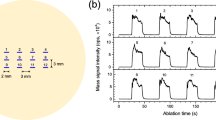Summary
The determination of different chemical species of arsenic in aquatic media has been carried out using several separation and detection techniques. As separation techniques GC, HPLC, HG and cold trap-selective thermal desorption are the most frequently used. As detection techniques FAAS, ETAAS or, to a lesser extent, ICP-AES are applied. In this work the optimization conditions are presented for As(III), As(V), monomethylarsonic acid (MMA) and dimethylarsinic acid (DMA) determination using (IC)HPLC coupled to HG with gas-liquid separator, and using ICP-AES as detector is presented. The gas-liquid separator impedes the entrance of mobile phase into the nebulizer and consequently into the plasma torch. The experimental conditions for HG (kind of acids and concentration, borohydride concentration, reagent flows) as well as plasma conditions have been optimized.
The quality parameters: LOD, precision and accuracy are reported for all the species studied.
Similar content being viewed by others
References
Hutzinger O (1982) The handbook of environmental chemistry, vol 3, part B, Anthropogenic compounds. Springer, Berlin Heidelberg New York
Craig PJ (ed) (1986) Organometallic compounds in the environment. Principles and reactions. Longman Group, England
Harrison RM, Rapsomanikis S (1989) Environmental analysis using chromatography interfaced with atomic spectroscopy. Ellis Horwood, Chichester
Craig PJ, Glockling F (eds) (1987) The biological alkylation of heavy elements. The Royal Society of Chemistry, London
Batley GE (ed) (1989) Trace element speciation: analytical methods and problems. CRC Press, Boca Raton, Florida
Braman RS, Johnson DL, Foreback CC, Ammons JM, Bricker JL (1977) Anal Chem 49:621–625
Andreae MD (1977) Anal Chem 49:820–823
Crecelius EA (1978) Anal Chem 50:826–827
Howard AG, Arbab-Zavar MH (1981) Analyst 106:213–220
Spall WD, Lynn JG, Andersen JL, Valdez JG, Gurley LR (1986) Anal Chem 58:1340–1344
Branch KCC, Bancroft L, Ebdon L, O'Neill P (1989) Analytical Proceedings 26:73–75
Chana BS, Smith NJ (1987) Anal Chim Acta 197:177–196
Ebdon L, Hill S, Walton AP, Ward RW (1988) Analyst 113: 1159–1165
Bushee DS, Krull IS, Demko PR, Smith SB Jr (1984) J Liquid Chromatogr 7
Haswell SJ, O'Neill P, Bancroft KCC (1985) Talanta 32:69–72
Ricci GR, Shepard LS, Colovos G, Hester NE (1981) Anal Chem 53:610–613
Tye CT, Haswell SJ, O'Neill P, Bancroft KCC (1985) Anal Chim Acta 169:195–200
Maitani T, Uchiyama S, Saito Y (1987) J Chromatogr 391:161–168
Author information
Authors and Affiliations
Rights and permissions
About this article
Cite this article
Rauret, G., Rubio, R. & Padró, A. Arsenic speciation using HPLC-HG-ICP-AES with gas-liquid separator. Fresenius J Anal Chem 340, 157–160 (1991). https://doi.org/10.1007/BF00324472
Received:
Issue Date:
DOI: https://doi.org/10.1007/BF00324472



